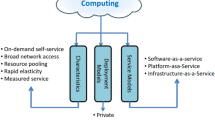Abstract
Trust plays an important role in commercial cloud environments. It is one of the biggest challenges of cloud technology. Trust enables users to select the best resources in a heterogeneous cloud infrastructure. We introduce a novel trust model based on past credentials and present capabilities of a cloud resource provider. Trust value is calculated using four parameters such as availability, reliability, turnaround efficiency, and data integrity. A trust management system is proposed implementing this trust model. The paper describes how a service level agreement is prepared combining quality of service requirements of user and capabilities of cloud resource provider. We also demonstrate that our proposed model performs better than the first in first out model and similar trust models.






Similar content being viewed by others
References
Abbadi, I. M., & Alawneh, M. (2012). A framework for establishing trust in the cloud. Computers & Electrical Engineering, 38(5), 1073–1087.
Calheiros, R. N., Ranjan, R., Beloglazov, A., De Rose, C. A. F., & Buyya, R. (2011). CloudSim: a toolkit for modeling and simulation of cloud computing environments and evaluation of resource provisioning algorithms. Software: Practice and Experience (SPE), 41(1), 23–50.
Chandrasekar, A., Chandrasekar, K., Mahadevan, M., & Varalakshmi, P. (2012). QoS monitoring and dynamic trust establishment in the cloud. In Lecture notes in computer science: Vol. 7296. Advances in grid and pervasive computing (pp. 289–301).
Chen, Z., Yao, W., & Wang, C. (2013). Security and trust model for data disaster-recovery service on the cloud, trustworthy computing and services. Communications in Computer and Information Science, 320, 140–147.
Firdhous, M., Ghazali, O., & Hassan, S. (2011). Trust management in cloud computing: a critical review. International Journal on Advances in ICT for Emerging Regions (ICTer), 04(02), 24–36.
Grandison, T., & Sloman, M. (2000). A survey of trust in Internet applications. IEEE Communications Survey and Tutorials. Fourth quarter.
Gupta, P., Kumar Goyal, M., Kumar, P., & Aggarwal, A. (2013). Trust and reliability based scheduling algorithm for cloud IaaS. In Lecture notes in electrical engineering: Vol. 150. Proceedings of the third international conference on trends in information, telecommunication and computing (pp. 603–607).
Hwang, K., & Li, D. (2010). Trusted cloud computing with secure resources and data coloring, trust reputation management. IEEE Internet Computing, 14(5), 14–22.
IEEE 90—Institute of Electrical and Electronics Engineers (1990). IEEE standard computer dictionary: a compilation of IEEE standard computer glossaries, New York.
Ko, R. K. L., Lee, B. S., & Pearson, S. (2011). Towards achieving accountability, auditability and trust in cloud computing. In Communications in computer and information science: Vol. 193. Advances in computing and communications (pp. 432–444).
Krautheim, F. J., Phatak, D. S., & Sherman, A. T. (2010). Introducing the trusted virtual environment module: a new mechanism for rooting trust in cloud computing. In Lecture notes in computer science: Vol. 6101. Trust and trustworthy computing (pp. 211–227).
Manuel, P. D., Abd-El Barr, M. I., & Thamarai Selvi, S. (2011). A novel trust management system for cloud computing—IaaS providers. Journal of Combinatorial Mathematics and Combinatorial Computing, 79, 3–22.
Messina, F., Pappalardo, G., Rosaci, D., Santoro, C., & Sarné, G. M. L. (2013). A trust-based approach for a competitive cloud/grid computing scenario. Studies in Computational Intelligence, 446, 129–138. Intelligent distributed computing VI.
Noor, T. H., & Sheng, Q. Z. (2011). Trust as a service: a framework for trust management in cloud environments. In Lecture notes in computer science: Vol. 6997. Web information system engineering—WISE 2011 (pp. 314–321).
Pearson, S. (2013). Privacy, security and trust in cloud computing, privacy and security for cloud computing. Computer Communications and Networks, 3–42.
Sun, D., Chang, G., Sun, L., & Wang, X. (2011). Surveying and analyzing security, privacy and trust issues in cloud computing environments. Procedia Engineering, 15, 2852–2856.
Takabi H., Joshi, J. B. D., & Ahn, G. (2010). Security and privacy challenges in cloud computing environments. IEEE Security & Privacy, 8(6), 24–31.
Urquhart, J. (2009). The biggest cloud-computing issue of 2009 is trust. C-Net News, 7 Jan. 2009. http://news.cnet.com/8301-19413_3-10133487-240.html.
Zhou, Q., Yu, J., & Yu, F. (2011). A trust-based defensive system model for cloud computing. In Lecture notes in computer science: Vol. 6985. Network and parallel computing (pp. 146–159).
Acknowledgement
This work is supported by Kuwait University, Research Grant No. [WI 07/11].
Author information
Authors and Affiliations
Corresponding author
Rights and permissions
About this article
Cite this article
Manuel, P. A trust model of cloud computing based on Quality of Service. Ann Oper Res 233, 281–292 (2015). https://doi.org/10.1007/s10479-013-1380-x
Published:
Issue Date:
DOI: https://doi.org/10.1007/s10479-013-1380-x




